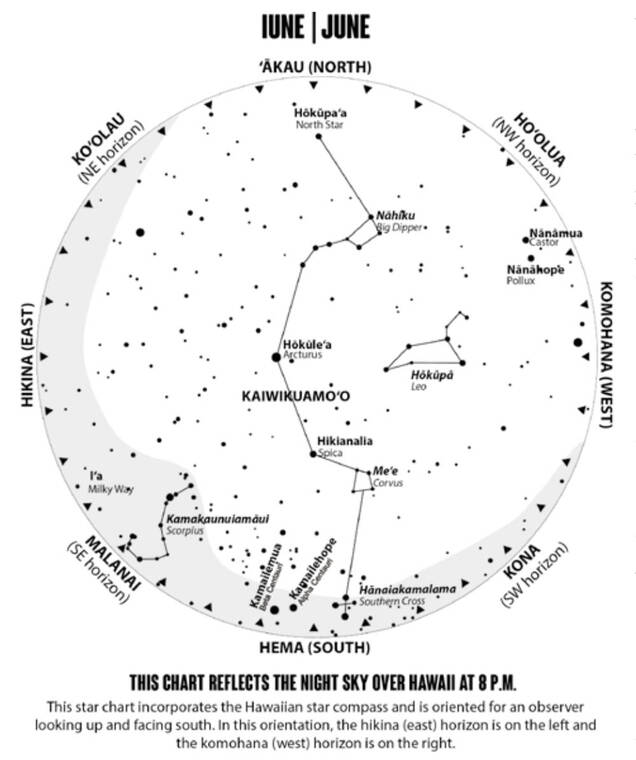
Featured Mauna Kea observatory news
‘Olelo Hawaii (Hawaiian language) students on Hawaii island have named a new instrument at the Canada-France-Hawaii Telescope that will help astronomers study the universe in greater detail. The Hawaiian naming project is part of the A Hua He Inoa program at ‘Imiloa Astronomy Center at University of Hawaii at Hilo.
The instrument’s name, Wenaokeao, meaning “earliest glow of light,” was given after extensive research by high school haumana (students) from Hawaiian medium education school Ke Kula ‘o Nawahiokalani‘opu‘u, who are interns in the A Hua He Inoa program at ‘Imiloa. The name describes the soft glow of the rising sun seen during the fleeting moments when the full moon lowers on the horizon, just before dawn breaks. Students chose the name after they visited CFHT on the summit of Mauna Kea, and were also advised by Larry Kimura, an associate professor of Hawaiian language and Hawaiian studies at UH Hilo.
“When we dissect the name ‘Wenaokeao,’ we look at the Hawaiian words ‘wena’ and ‘ao,’” said Tinai Liusa, a senior at Ke Kula ‘o Nawahiokalani‘opu‘u. “‘Wena’ references the colors seen in the morning sunrise. ‘Ao’ is the entire world that we see and all of the colors in it. These combined meanings correlate with the instrument because the instrument helps to observe the colors of light emitted from stars.”
Previously known as Vision, the CFHT project combines existing instruments to expand scientific capabilities. The upgrade will allow astronomers to detect magnetic fields and planets around distant stars in a larger wavelength simultaneously.
“I think it’s a wonderful opportunity for the students to practice cultural naming. It’s an honor for us to participate in the process and then to be gifted a name for this instrument,” said Mary Beth Laychak, director of communications and community engagement at CFHT.
The A Hua He Inoa program, led by ‘Imiloa, creates a pathway where language and culture are at the core of modern scientific practices, melding Indigenous culture and science locally, nationally and worldwide. Previous naming projects include Powehi, the first black hole ever pictured, and ‘Oumuamua, the first interstellar object discovered.
“I am really proud of our A Hua He Inoa cohort for their contribution to naming Wenaokeao,” said Ku‘ulei Bezilla, project planner at ‘Imiloa. “Their dedication in this process reflects a harmonious blend of place-based knowledge and scientific exploration, enriching our celestial understanding and underscoring the vital role of our Hawaiian language and perspective in guiding our view of the universe.”
Special events
June 20 marks the Northern Hemisphere’s summer solstice, when Earth’s North Pole is at its maximum tilt toward the sun. On this day the Northern Hemisphere experiences its longest period of daylight.
The day length for Honolulu on the solstice will be 13 hours and 25 minutes. Up until the solstice the days were growing longer, and after the solstice the days will begin to grow shorter once again.
Evening observing
During the early evening hours of June, the navigational star family of Kaiwikuamo‘o will stretch across the entire sky. This enormous “super constellation” begins with Hokupa‘a, the North Star, and ends at Hanaiakamalama, the Southern Cross.
To trace this star family, start by connecting Hokupa‘a with Nahiku, also known as the Big Dipper. From the arc of Nahiku, we pass down to Hokule‘a (Arcturus) and then to Hikianalia (Spica). The bottom of Kaiwikuamo‘o is seen by passing through the bucket shape of Me‘e, also known as Corvus, and dropping straight down to Hanaiakamalama, the Southern Cross.
Because this star family stretches across so much of the sky, the entire star family can be seen only at certain latitudes within the northern tropics. Because of this, the different components of the star family are essential tools for navigators on voyaging canoes like Hokule‘a and Hikianalia, two waa with the Polynesian Voyaging Society that are named after stars in Kaiwikuamo‘o.
In the southern sky, just next to Hanaiakamalama, observers can see Kamailehope (Alpha Centauri) and Kamailemua (Beta Centauri). Beta Centauri is a triple star system of three bright stars that are about 400 light-years away from Earth. Alpha Centauri, also a triple star system of smaller and fainter stars, is the closest star system to our sun at only 4 light-years away.
Morning observing
Throughout June, the sun will rise just about 10 minutes before 6 a.m.
In the early morning hours, Mars and Saturn will be visible throughout the month. After about the first week, they will be joined by Jupiter in the northeastern sky just before the sun rises. Just to the west of Jupiter will be the Makali‘i star cluster (Pleiades).
Early morning observers will also be able to pinpoint two star families: Manaiakalani and Kalupeakawelo.
The Manaiakalani starline is made up of three main pieces: the Navigator’s Triangle, Pimoe (a mischievous ulua fish) and Kamakaunuiamaui, the fishhook of Maui. Making up the Navigator’s Triangle are the three stars Pira‘etea (Deneb) in the constellation Cygnus, Keoe (Vega) in the constellation Lyra and Humu (Altair) in the constellation Aquila.
Following to the east will be Kalupeakawelo, also known as “the Kite of Kawelo.” This star family is made up of the Great Square of Pegasus, a square-shaped kite that rises from the eastern horizon and flies overhead toward the western horizon. The four stars of the Great Square are named for Hawaiian chiefs: Keawe of Hawaii island, Pi‘ilani of Maui, Kakuhihewa of Oahu and Manokalanipo of Kauai.
Lines guide the kite overhead, anchored in the north to ‘Iwakeli‘i (Cassiopeia) and Kamo‘i (Cepheus). In the South they are held in place by Pi‘ikea (Diphda), Kaikilani (Ankaa), Kalanikauleleaiwi (Archenar), Kukaniloko (Fomalhaut) and Nalani (Alnair).
The ‘Imiloa Astronomy Center of Hawaii is a center for informal science education at the University of Hawaii at Hilo showcasing astronomy and Hawaiian culture as parallel journeys of human exploration.
Read More: World News | Entertainment News | Celeb News
Star Ads






